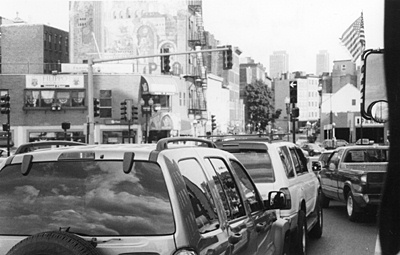All Nonfiction
- Bullying
- Books
- Academic
- Author Interviews
- Celebrity interviews
- College Articles
- College Essays
- Educator of the Year
- Heroes
- Interviews
- Memoir
- Personal Experience
- Sports
- Travel & Culture
All Opinions
- Bullying
- Current Events / Politics
- Discrimination
- Drugs / Alcohol / Smoking
- Entertainment / Celebrities
- Environment
- Love / Relationships
- Movies / Music / TV
- Pop Culture / Trends
- School / College
- Social Issues / Civics
- Spirituality / Religion
- Sports / Hobbies
All Hot Topics
- Bullying
- Community Service
- Environment
- Health
- Letters to the Editor
- Pride & Prejudice
- What Matters
- Back
Summer Guide
- Program Links
- Program Reviews
- Back
College Guide
- College Links
- College Reviews
- College Essays
- College Articles
- Back
China's Futuristic Bus Floats Over Traffic
Anyone who has travelled to China before and been on the road can vouch for this statement: the traffic can be insane. Not only are there a tremendous amount of cars and buses on the roads that lead to to congestion and drastic delays, but there are also an abundance of impatient and brash drivers. These traffic conditions are a result of China’s urbanization; up until 2010, China’s urban population had always been less than its rural population, but now millions of farm dwellers are moving to the cities and causing overcrowding in terms of housing and traffic. This rising number of people on the roads, however, is not only inciting the irritation of millions of people as they try to reach work or return home on time, it is also leading to more car collisions and pedestrian accidents and playing a factor in China’s smog crisis. Recently, China has decided to combat this alarming problem by test-driving the world’s first Transit Elevated Bus (TEB), a bus that “glides” over cars to reduce traffic.
TEBs are electric-powered vehicles that straddle over two lanes of a highway, allowing cars to pass underneath. Since these futuristic buses occupy two lanes’ space on highways, they can also fit more people than regular buses: a single cabin can transport up to 300 people, and as many as four cabins can be attached together. Also, the cabins are much more comfortable than the crowded seats and aisles of China’s conventional buses and trains. Plush, white seats line the sides of the bus and there are curved sectionals around the center, which all add to the modern and comfortable atmosphere of the bus. And for those who need to stand, there are plenty of handrails and standing poles situated all around the bus’s interior.
Not only will it alleviate traffic by allowing buses and cars to literally share the road, but it will also be a more economic and eco-friendly alternative to traditional buses. This bus-train hybrid is believed to be more fuel-efficient and economical than building a subway system (although each TEB is 30 million renminbi, or $4.5 million, the TEB’s designer claims this is a one-sixteenth of the cost of a subway train), and because it is powered by electricity it will mitigate the country’s air pollution. The designers say one TEB could replace 40 conventional buses, reducing fuel consumption by 882 tons per year.
However, many are raising concerns against the innovative TEBs. First off, although the entire TEB’s height is nearly 16 feet, there is only 7 feet of space in between the bottom of the TEB and the ground beneath it. This limited space means large cars could get stuck in between the TEB and the ground, and so the TEB’s designers state the road system will have to be altered to restrict tall cars, trucks, and buses from driving on the same roads as TEBs. Also, drivers must be careful about not driving too close to the edges of the road, since TEB wheels straddle the sides of the road. And when drivers do want to merge lanes, they must wait for the TEB to move past them until they can do so. As for when the TEB turns a corner, the cars underneath must wait until the bus has fully turned before continuing, which may be a hassle and a danger. To address these problems, the TEB’s head designer Song Youzhou claims that guardrails will be constructed between the bus tracks and the car lanes that pass underneath the TEBs. In addition, these rails will have the ability to absorb at least 70 percent of a collision’s impact.
In addition, the maintenance of TEBs brings up some inconveniences. Since TEBs are much larger than your usual electric-powered vehicle, they need a lot of power to get from Point A to Point B at 40 miles per hour (their maximum speed). TEBs are partly powered by solar panels, but because solar panels are not effective enough designers are proposing “relay charging,” which is when TEBs charge for a short period of time at each station so they have just enough energy to reach their next station. Also, maintenance workers repairing or cleaning the bus must be provided with harnesses or other safety measures, since the buses are very tall and falls could be deadly.
First shown at the Beijing International High-Tech Expo in 2010, many doubted the bus’s feasibility, but after improving the bus’s design and showing it again at this year’s expo, five Chinese cities have agreed to test-drive the TEBs. The very first testing of this futuristic bus’s internal systems occurred on August 2nd in Qinhuangdao, a northern port city in China. If all goes well with the construction plans and test runs, TEBs may be China’s much needed traffic and smog relief. As Wang Peng, director of the Shenyang chamber of commerce, says, “In 2010, the bus was only a dream, but now it is in a mature stage.”

Similar Articles
JOIN THE DISCUSSION
This article has 0 comments.
